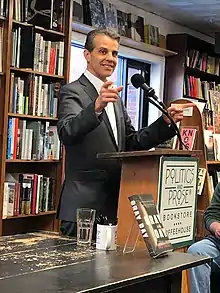Eric O'Neill
Eric Michael O'Neill (born March 3, 1973) is an American former FBI counter-terrorism and counterintelligence operative. He worked as an Investigative Specialist with the Special Surveillance Group (SSG) and played a major role in the arrest, conviction, and imprisonment of FBI agent Robert Hanssen for spying on behalf of the Soviet Union and Russia. His book written about this experience, Gray Day: My Undercover Mission to Expose America's First Cyber Spy, was published in Spring 2019. He is a public speaker and security expert who currently lectures internationally about espionage and national security, cybersecurity, fraud, corporate diligence and defense, hacking, pursuing dreams and surviving Hollywood.[1][2][3]
Eric O'Neill | |
|---|---|
 O'Neill speaking about his book, Gray Day, at Politics and Prose Bookstore in Washington, D.C., March 2019 | |
| Born | March 3, 1973 |
| Nationality | American |
| Education | Auburn University The George Washington University Law School |
| Occupation | Public speaker/security expert, lawyer[1] |
| Employer | Global Communities |
| Known for | Robert Hanssen investigation |
| Spouse(s) | Juliana O'Neill |
| Website | ericoneill |
Early life
O'Neill graduated from Gonzaga College High School in Washington, D.C., in 1991. He earned a B.A., with Honors, in political science and psychology from Auburn University in 1995, where he was a brother of Theta Xi fraternity.[1][2][3]
Career
FBI
After a career as a counterintelligence and counter-terrorism field operative, O'Neill was assigned to report to Hanssen in the newly established Information Assurance Section. His true role was to learn as much as possible about what information Hanssen had divulged to the Soviet Union and Russia. Ultimately, investigators made a dramatic move to obtain a "smoking gun". While others briefly disrupted Hanssen's routine and confidence, maneuvering him into relaxing his rigid control of his Palm Pilot,[4] O'Neill, under intense time pressure, obtained the Palm Pilot, took it to FBI technical staff to download its encrypted contents, and returned it, apparently undetected. O'Neill notes that he could not recall which pocket he had taken the device from, and has speculated that had Hanssen detected the disturbance of his device, he would have realized that all hope of continued freedom was lost and might have shot O'Neill dead on the spot.
Hanssen was arrested on February 18, 2001, at Foxstone Park near his home in Vienna, Virginia, charged with selling American secrets to Russia for $1.4 million in cash and diamonds over a 22-year period. O'Neill's subterfuge had apparently deceived Hanssen, as part of the dead drop contained an evaluation of O'Neill's possibly replacing Hanssen as a mole when he retired. On 6 July 2001, Hanssen pleaded guilty to 15 counts of espionage.[5][6] Hanssen was sentenced to life in prison. His treason has been described as "possibly the worst intelligence disaster in US history."[2][7]
Post-FBI
Following the Hanssen case, O'Neill decided to leave the FBI in order to focus on law school. O'Neill earned a J.D. with honors from The George Washington University Law School in 2003. He has been admitted to the bar in Maryland and in the District of Columbia. After graduating from law school, O'Neill joined DLA Piper US LLP as a Senior Associate in the Government Contracts Group. In December 2008, O'Neill left DLA Piper and accepted a position as General Counsel of Global Communities, formerly CHF International, a global humanitarian relief non-profit organization.[1][2]
In February 2009, O'Neill co-founded The Georgetown Group, an investigative and risk management company.[1][8]
In July 2013, O'Neill co-founded the Schiltron Group, a supply chain assurance and critical infrastructure protection company.[9]
On March 16, 2016, O'Neill was named National Security Strategist for Carbon Black, a leader in Next-Generation Endpoint Security (NGES).[10]
Media portrayals
O'Neill is portrayed by Ryan Phillippe in the 2007 thriller Breach, which depicts O'Neill's role in the investigation and capture of Hanssen. A feature-length commentary track on the DVD features O'Neill with director Billy Ray. O'Neill expands on the film, offering additional background and details, as well as noting where actual events were changed on the film for dramatic purposes.[11][12][13]
O'Neill's memoir about the Hanssen case, Gray Day: My Undercover Mission to Expose America's First Cyber Spy, was published by Penguin Random House in Spring 2019.[14] Publishers Weekly has called the book "as compulsively readable as any thriller".[15]
References
- "Eric O'Neill | LinkedIn". Linkedin.com. Retrieved 2013-03-26.
- O'Neill, Eric. "Eric O'Neill - Official Website". Ericoneill.net. Retrieved 2013-03-27.
- David Morrison and Mike Clardy, Auburn University, "AU Alum’s Role in Capturing Spy Inspires Motion Picture Breach", February 13, 2007; retrieved February 21, 2007
- Fresh Air with Terry Gross, "Eric O'Neill and Billy Ray Discuss Breach", retrieved January 31, 2007
- Transcript of Hanssen Guilty Plea, July 6, 2001; retrieved February 22, 2007
- United States Department of Justice, Thompson Statement Regarding Hanssen Guilty Plea, July 6, 2001; retrieved February 22, 2007
- U.S. Department of Justice, "A Review of FBI Security Programs", March 2002
- "The Georgetown Group". Retrieved 2011-05-24.
- "Schiltron Group LLC". Retrieved 2013-07-31.
- "Carbon Black Names Eric O'Neill National Security Strategist". Carbon Black. Retrieved 2017-10-13.
- Ivana Redwine. "Breach DVD - DVD Pick". About.com. Retrieved 2011-05-24.
- "The DVD Journal - Quick Reviews: Breach". The DVD Journal. Retrieved 2011-05-24.
- "Spy Robert Hanssen, FBI's Eric O'Neill - Breach Movie True Story". Chasingthefrog.com. Retrieved 2013-03-26.
- "Gray Day by Eric O'Neill | PenguinRandomHouse.com: Books". PenguinRandomhouse.com. Retrieved 2019-03-22.
- www.publishersweekly.com https://www.publishersweekly.com/978-0-525-57352-4. Retrieved 2019-03-22. Missing or empty
|title=(help)